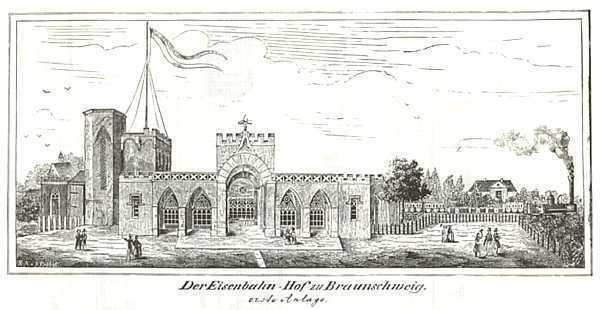 | ||
The Duchy of Brunswick State Railway (Herzoglich Braunschweigische Staatseisenbahn) was the first state railway in Germany. The first section of its Brunswick–Bad Harzburg railway line between Brunswick and Wolfenbüttel opened on 1 December 1838.
Contents
Opening
The construction of the line was mainly the work of the entrepreneur Philipp August von Amsberg, privy councillor to Duke William of Brunswick. Amsberg investigated the transportation links from the land-locked Duchy of Brunswick to the Hanse cities of Hamburg, Bremen and Lübeck and recognised that the transportation of wood and mining products from the duchy's estates in the Harz mountain range to the maritime harbours was not competitive. Conversely products from the seaboard harbours tended to be transported on the Elbe river to Magdeburg in the Prussian Province of Saxony but not to Brunswick. In 1824 he proposed, in a memorandum, a plan to build railway links from Brunswick through the Kingdom of Hanover to the cities of Hamburg and Bremen. These ideas were publicised in 1832 but foundered on German sectionalism (Kleinstaaterei).
In 1835 Amsberg again looked into the plan to build an eastern railway from Brunswick via Helmstedt to Magdeburg. This plan was given up in favour of a later route via Oschersleben in order to form a junction there to the Prussian Magdeburg–Halberstadt line. In the same year, the first steam-hauled railway line in Germany, the Bavarian Ludwig Railway, opened between Nuremberg and Fürth. At the instigation of Amsberg, the Brunswick state ministry finally made the decision to build a railway line from Brunswick southwards to Wolfenbüttel and the exclave of Bad Harzburg (until 1892: Neustadt) – the Brunswick–Bad Harzburg railway – and thereby pre-empt the intent of the Hanoverian government to build an eastern railway via Halberstadt to Magdeburg, which would bypass Brunswick to the south.
On 1 August 1837 construction began on the first section from Brunswick in southern direction and on 30 November 1838 the route was inaugurated by Duke William riding on a train to Wolfenbüttel hauled by a Blenkinsop locomotive. Opened to traffic the next day, it was the first German state railway and the fourth railway line to be built in the German Confederation. On 31 October 1841 the line to Bad Harzburg via Vienenburg was completed. The Vienenburg station opened in 1840 on Hanover territory is today the oldest railway station in Germany which is still in use. The ascent from here to the rim of the Harz range was initially worked by horses, but by 1843 steam haulage had been introduced on this section too, using three locomotives built in England. These engines were the first six-coupled locomotives in Germany.
In 1850, Philipp-August von Amsberg became head of the Duchy's Railway and Postal Division in Brunswick.
Development of the network
Takeover by the state of Prussia
After the 1866 annexation of Hanover by Prussia, the Brunswick lines were entirely surrounded by the Prussian state railways. In 1869 Amsberg entered into the sale of the Brunswick State Railway to Prussia with a heavy heart. The Duchy of Brunswick had amassed heavy debts at that time, that had arisen mainly due to the expansion of the railway.
In March 1870, with effect from 1 January 1869, the Brunswick State Railways were transferred to a private railway concern, the Brunswick Railway Company. Amsberg did not survive to see the Prussian state buy up the shares in this company between 1879 and 1882, operate it under the Prussian state railways and subordinate it in 1886 to the royal railway division (Eisenbahndirektion) of Magdeburg.
